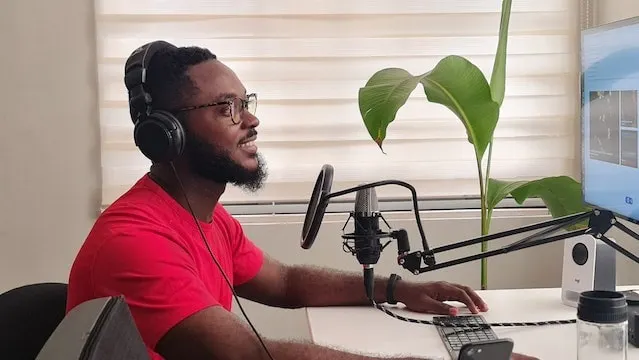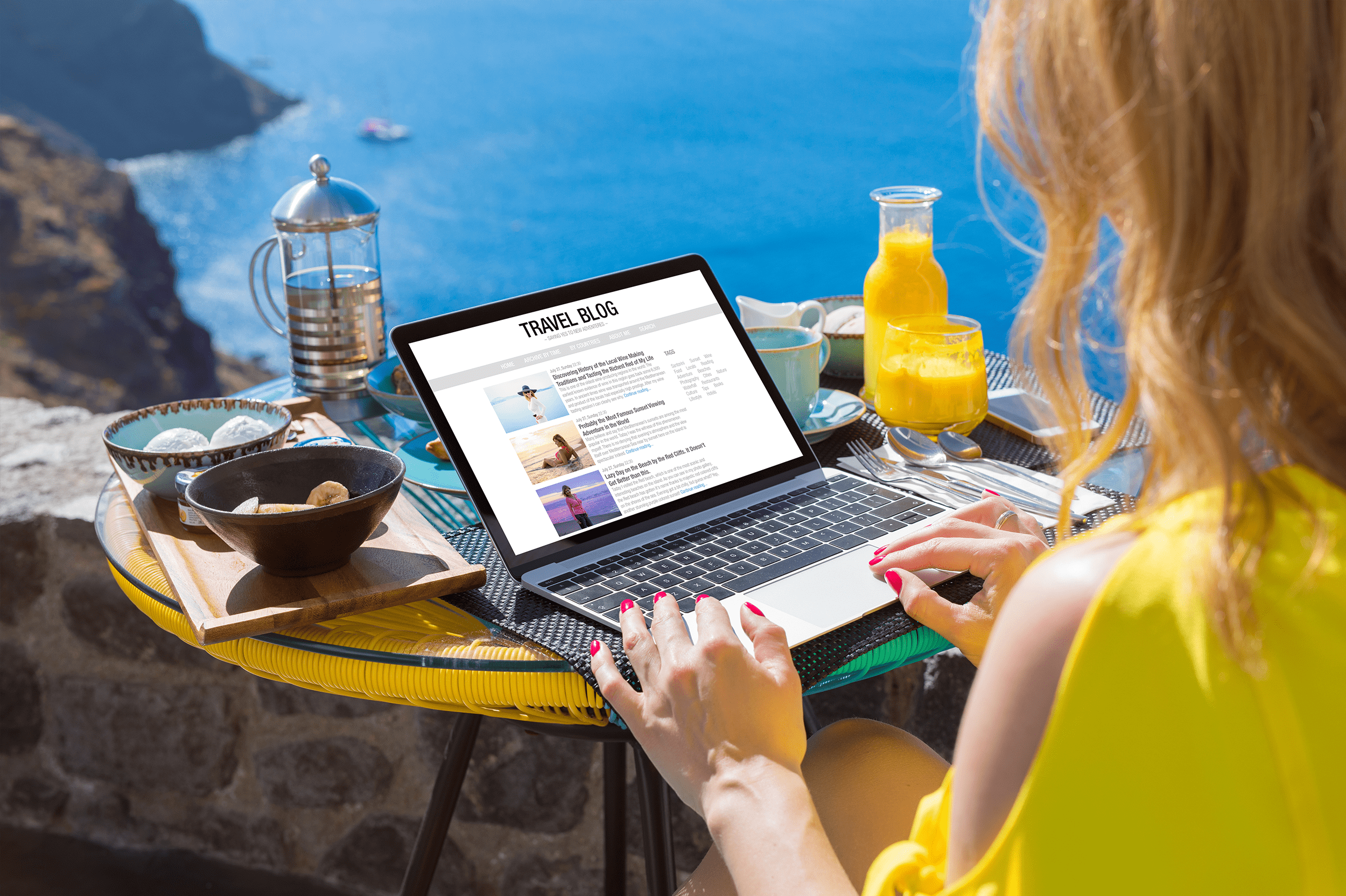If you haven’t yet branched out into the podcasting world, you could be missing out on a unique way to reach and grow your brand’s audience. As of 2022, 62% of people aged 12 or older have listened to a podcast. And, 80 million Americans listened to podcasts weekly in 2021, rising 17% from the previous year.
As the popularity of podcasting increases, now is the best time to start your podcasting journey. Find the following topics in this guide to help you learn how to set up and manage a podcast:
Why Podcast?

Photo by George Milton via Pexels
Some podcasters start a show for fun, never expecting it to become a viable stream for building client bases and strengthening their audiences. However, podcasts can generate revenue, boost brand awareness, and more.
Podcasts are Convenient for Listeners
Some podcasters record their episodes using both video and audio, allowing them to publish their episodes to YouTube as well as podcast networks, while others use just audio. Either way, podcasting offers convenient access for fans, allowing them to tune in via audio only when watching a video isn’t realistic.
Podcasts are ideal for multi-tasking. According to NuVoodoo, 49% of podcast listeners tune in to a podcast’s audio while driving — a much safer alternative than watching a video. Listeners can also catch an episode when working out, cooking, or working, all of which can be challenging times to consume video.
Podcasting Builds Strong Connections with an Audience
Podcasts create intimate, authentic connections with their audiences. For instance, listeners can learn more about a host in a podcast episode than they might on social media, as podcasts offer time for deep discussions and meaningful conversations.
As a host, you might consider making your show interactive with your audience by letting listeners call in or send in questions for you to answer on-air. You also can set up a Q&A or poll to ask listeners what topics they’re most interested in.
You Can Establish Your Authority
With a niche podcast, you can show your expertise in your industry. Sharing insights, interviewing experts, and discussing relevant news and research can all lead to establishing and growing your authority in a particular subject. In turn, this could open the doors to more clientele and opportunities for your business.
Podcasters Can Make Money
Sponsorships, affiliate marketing, and more awareness of a business’s products and services via a successful podcast can all generate revenue for a podcaster. Although it can take time to grow your audience enough to qualify for the best sponsorships and other money-making opportunities, your podcast can become a reliable income stream eventually.
How to Setup a Podcast

Photo by Jeremy Enns via Pexels
Setting up a podcast isn’t overtly challenging, but taking the right steps now can help podcasters start on the right foot.
Step 1: Choose a Topic
What will you podcast about? This is the single most important decision you can make as a future podcaster.
While many podcasts overlap in general topics, the ones that stand out to listeners usually offer unique angles or formats for the topics they cover. First, decide on the topics you’d like to discuss, which are likely ones that align with your business or industry. For instance, therapists might talk about mental health and wellness, while attorneys may discuss law topics or true crime.
With your general topics set, drill down further into more specific topics that you can create content around. If you’re having trouble creating episode ideas on a topic, it might be best to rethink your approach. It’s also okay to cover multiple topics on your podcast. However, choosing topics that fit your brand is the best way to build an audience and position yourself as an authority.
Step 2: Decide on a Format

Photo by Karolina Grabowska via Pexels
Next, consider various podcast formats and which one or combination of formats you’d like to use. Most commonly, podcasts follow one of the following formats:
- Solo host: These podcasts have just one host, although guests may occasionally join.
- Co-hosts: These podcasts include more than one regular host.
- Guest hosts: Some podcasts have a new guest for each episode that joins in the conversation with the host.
- Interviews: Interview-focused podcasts typically have one or two hosts who interview guests as the main portion of each episode.
Within these formats, there are various types of podcast episodes. If you have a guest, the episode can be formatted as an interview or a discussion. If you’re hosting an episode solo, fiction and non-fiction storytelling are common formats, as well as a solo conversation format.
Many popular podcasts combine two or more formats to vary episodes and keep their audiences engaged. Still, it’s a good idea to have a plan for your primary format and the other formats you’d like to include occasionally as you create a content calendar and plan for your first episodes.
Finally, consider episode length and how it matters to your ideal audience. Short podcasts fall between 10-20 minutes and are best for audiences with very busy schedules who like to consume content quickly. These might work for podcasts targeting single parents or busy executives.
Longer podcasts can run from 45 minutes to over an hour. They’re excellent for covering in-depth topics and interviews. Typically, news-focused, lifestyle, and entertainment podcasts use longer formats.
Step 3: Buy Equipment
To start a podcast, you’ll need recording software and a microphone. If also recording video, you’ll need a video camera or your mobile phone’s camera.
However, if your budget allows, you might consider purchasing more podcast equipment now rather than later. Popular podcasts typically have high-quality software and equipment to give their audiences the best listening and viewing experiences possible.
For instance, headphones can help you adjust your audio volume and quality while recording. And, high-end microphones ensure clear speech while drowning out background noises. Audio mixers and mixing software let you add sounds and jingles to your podcast. You can also find free music clips to use from a variety of sources.
It’s best to start your podcast the same way you’d expect it to be one or two years from now to ensure a smooth experience for listeners. Here are a few recommendations for equipment to consider:
- Microphones: Blue Yeti, JLab Talk Go USB Microphone, MXL 990
- Headphones: Sony Pro, Audio-Technica Broadcast Stereo Headset, Moondrop Aria
- Recording Software: Adobe Audition, GarageBand, Auphonic
- Audio Mixers: Yamaha AG06, Behringer XENYX, Zoom PodTrak P4
Step 4: Design Creatives
At the least, a podcast needs an associated thumbnail image that will display on the podcast directories you choose to publish on, like Spotify or Apple Podcasts. This thumbnail makes your podcast easily recognizable by listeners and your potential audience. Podcast thumbnails usually take on one of three forms:
- Logos: Using a logo is best if your podcast relates to your business and your business logo is recognizable by your audience already.
- Photos: Podcasts with a consistent cost or co-hosts sometimes have up-close photos of the hosts as the primary design with the podcast name added as an overlay. You can create a photo-focused thumbnail quickly using a photo-editing app like Canva.
- Illustrations: A newer trend with podcast thumbnails is illustration that relates to the podcast’s usual topics. For example, CNN’s Diversifying and TED and PRX’s How to Be a Better Human use illustrations to give their audiences a glimpse of what they discuss. Check out designers on Fiverr, Etsy, Upwork, and other marketplaces to get custom artwork.
Next, think about the intro and outro music you’ll use for your podcast. Not all podcasts use music, but it can be a good way to build engagement and awareness for your podcast. Browse MixKit and Podcast.co for tracks to use.
Step 5: Plan and Record Your First Episodes

Photo by Emmanuel Jason Eliphalet via Pexels
Plan episodes using an outline to guide your talking points or conversations. Be sure to give your guests or co-hosts a copy of the outline to keep everyone on the same page while recording. This outline can help you stay on track with time, especially if you break down each point into timed sections and use a clock or timer while recording.
Before recording, check all of your equipment by making a quick practice episode. Record a minute or two speaking into your microphone, and play the recording back to double-check your settings. Adjust the volume, quality, and microphone placement, if needed.
Finally, record your episode. Then, record a few more. To secure a podcast host, you’ll usually need a few episodes lined up, so have five or six edited final copies ready to go.
Step 6: Upload It
A podcast directory is a place where you’ll publish your podcast. Listeners use podcast directories like Spotify and Google Podcasts to listen to podcast episodes, save or follow podcasts, or download episodes to listen to offline.
You’ll first need a podcast host to submit your podcast to various directories. Podcast hosts give you the RSS feed necessary to submit your episodes to directories. Once you submit an RSS feed to your podcast, directories will automatically find and upload new episodes you’ve submitted.
The process of uploading podcast episodes varies by host. Popular options include Buzzsprout, PodBean, and Castos, which offer simple ways to upload and manage episodes without needing technical experience. Some starter plans are even free with limited storage, which can be helpful for brand-new podcasters.
Anchor.fm, Spotify’s free podcasting platform, is another great resource for beginners who are just getting started podcasting. With built-in recording and editing tools, you can create episodes easily and distribute them to the leading podcast listeners.
How to Manage Your Podcast
The next step is growing your podcast into one that’s successful with an engaged audience through marketing, building awareness, and monetization.
Bringing Others on Board

Photo by cottonbro via Pexels
Today’s podcasts that rank high in charts usually are more than one-person shows, even if many of those people stay behind the scenes. One of the best ways to grow and manage a podcast is to bring others along for help, like a producer, co-host, or guest hosts. Some podcasts also use scriptwriters to guide their talking points, sound and video editors to create high-quality episodes, and marketers to advertise and promote the podcast.
Delegating tasks is key. Doing so leaves some tasks with professionals who can handle them best, giving you more time to focus on the podcast and delivering excellent content. Outsource your podcast website’s management, social media, content research, and other tasks as soon as possible to keep scaling.
Marketing a Podcast
Have a few go-to ways to promote your podcast to keep bringing in new listeners. One of the most popular marketing avenues is through social media. Create a Facebook group for fans, tweet about your episodes a day or so before they launch, or cross-promote your podcast on your YouTube channel.
Also, submit your podcast to podcast aggregators, or apps and software databases that collect and play podcasts. In most cases, you can simply upload your RSS feed to an aggregator, like Overcast or TuneIn, for it to display in user feeds.
Podcast hosts also find success appearing on other podcasts as a guest host, which is one of many guerilla marketing tactics you can use to market your podcast (and your business). Usually, the hosting podcast lets its viewers know in advance when a guest will be on, allowing its listeners to learn more about you before the podcast airs. You may also get an opportunity to talk briefly about and plug your podcast on-air.
Getting Podcast Reviews
Positive podcast reviews or testimonials increase credibility and trust with an audience. This is why many hosts remind their listeners near the beginning or end of their episodes to leave a 5-star review on the platform if they enjoyed the show. Other listeners look to reviews to decide whether they want to tune into a specific podcast.
Although there’s always a chance for negative reviews, these are also learning opportunities. Take what you’ve learned from negative comments and use that information to improve your future content.
Furthermore, the more reviews your podcast has, the better its chances of moving up the rankings in a listening platform. An article in SoundGuys states that ratings equal increased visibility in Apple Podcasts, as the platform prioritizes popular podcasts. More ratings could even lead to better sponsorship opportunities, as it’s typically popular podcasts that advertisers want to collaborate with.
Making Necessary Upgrades
Photo by Pixabay via Pexels
As reviews start coming in for your podcast, you’ll begin to learn more about what your listeners want and need. Make upgrades that fit those needs when possible. For example, you might make your first big equipment upgrade at the one-year mark. You can also tweak your content, adding in new formats or more topics at the request of your listeners. Browse through feedback regularly to gain insight into your listeners’ preferences.
Monetizing Your Podcast
Even if your podcast isn’t primarily for generating revenue, it can be another pathway toward monetizing your brand. Podcasters mostly monetize their podcasts through sponsorships, ads, and paid memberships — similar to the tactics you’d use to monetize a blog. Sponsorships tend to be the best way to monetize, especially for podcasts with large audiences. According to Improve Podcast, sponsorships and ads read by the podcast’s hosts are the most popular monetization pathway for 63% of high-income podcasters.
Reaching out directly to brands you’re interested in having as sponsors can effectively land sponsorships. Podcast hosting platforms sometimes also let you control and manage podcast ads or connect with sponsors looking for new podcasts to partner with.
You can also sell guest host spots to people who want to advertise their brand while joining in the conversation. According to Ashley Carman from Bloomberg, some podcasts accept paying guests with the highest bids for a guest host spot. Typically, the podcast host turns off all other ads for the episode, making the guest the prime advertiser. Carman adds that one guest host spot sold for $50,000.
More Resources on Podcasting
We’ve gathered more helpful resources about building a successful podcast to help you reach your goals:
- The Best Podcast Hosts (The Podcast Host)
- 7 Popular Podcast Formats (ConvertKit)
- How to Get Podcast Sponsors (Neil Patel)
- 8 Ways to Monetize a Podcast (Forbes)
- Podcast Ideas: 101 Ideas for Things to Talk About (Smart Passive Income)
- How To Invite Someone To An Interview On Your Podcast (Castos)
- How to Make Money Podcasting (The Best Media)
- Why You Need to Get Podcast Reviews and How to Get Them (Podcastle)
One easy way to market your podcast and start getting visibility on social media is by installing social media share buttons on your blog or website, allowing your visitors to share your episodes, episode summaries, or transcripts with their social media connections. Easy to install and free to use, ShareThis’ share buttons are available for more than 40 popular social networks.




